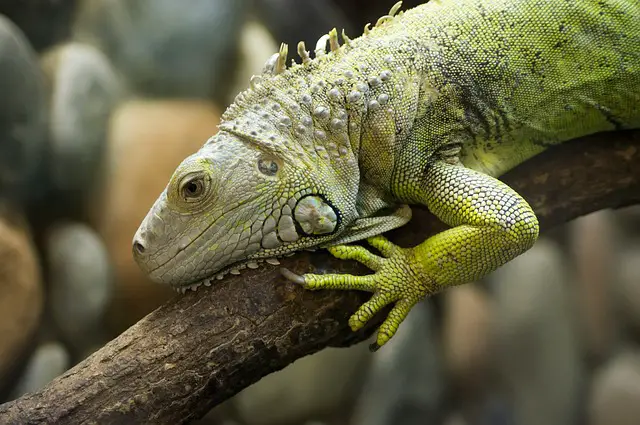Iguanas are fascinating creatures. These lizards can range in size from about two feet to six feet long. They are usually green, but some are blue, red, or orange. Iguanas can be found in tropical environments and must have warm temperatures to survive.
Can you pick up a wild iguana?
The answer is yes, but you need to be careful.
Iguanas can be aggressive, and their tails can pack a powerful whip-like punch.
If you decide to pick one up, make sure you support its body so its tail cannot reach you.
It’s also important to note that iguanas can carry diseases, so it’s best not to handle them if you can avoid them.
If you must pick up an iguana, always wash your hands afterward.
Iguanas can carry harmful bacteria that can cause infections in humans.
In addition, avoid touching your face or eyes after handling an iguana, as this can also lead to infection.
If an iguana ever bites you, seek medical attention immediately, as their bites can become infected quickly.
Can you touch wild iguanas?
When it comes to wild iguanas, the question of whether or not you can touch them is a bit of a tricky one.
On the one hand, these lizards are generally shy and usually try to avoid contact with humans.
On the other hand, they are not typically aggressive, and if you come into contact with one, it is unlikely to cause any harm.
In general, it is probably best to err on the side of caution and refrain from touching wild iguanas.
However, if you find yourself close to one of these creatures, there is no need to panic. Instead, just keep your hands to yourself and enjoy the experience from a safe distance.
How to catch a wild iguana?
If you’re lucky enough to live in an area where iguanas are native, you may be able to catch one in the wild.
However, it’s essential to beware of their razor-sharp claws and teeth, as they can be pretty aggressive when startled.
The best time to catch an iguana is during the day when they’re basking in the sun.
Carefully approach them from behind and grab them around the body, just behind the front legs. Once you have a firm grip, hold on tight – they can wriggle out of your grasp if you’re not careful!
If you’re successful in catching an iguana, take care when transporting it to its new home, as it can be pretty fragile. Getting the proper permits before keeping an iguana as a pet is also essential, as they are protected in many areas.
You can add a unique and exotic pet to your home with patience and luck.
Are wild iguanas dangerous?
Depending on the species, wild iguanas can range in size from two to six feet long and weigh up to 20 pounds. They are native to Central and South America, but in recent years they have become established in Florida, where they are considered an invasive species.
While they are generally docile animals, wild iguanas can be dangerous if provoked. They have sharp claws and teeth that can cause serious injury, and male iguanas are particularly aggressive during mating season.
In addition, wild iguanas can carry diseases that can harm humans, such as salmonella. As a result, it is best to avoid contact with these animals.
If you come into contact with a wild iguana, wash your hands thoroughly with soap and water.
Conclusion
While picking up a wild iguana is possible, it’s not advisable. These reptiles can be aggressive and may carry diseases that can harm humans. If you must pick one up, take precautions to avoid getting bitten or coming into contact with harmful bacteria.




